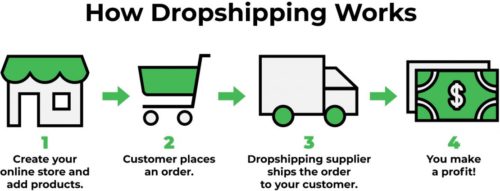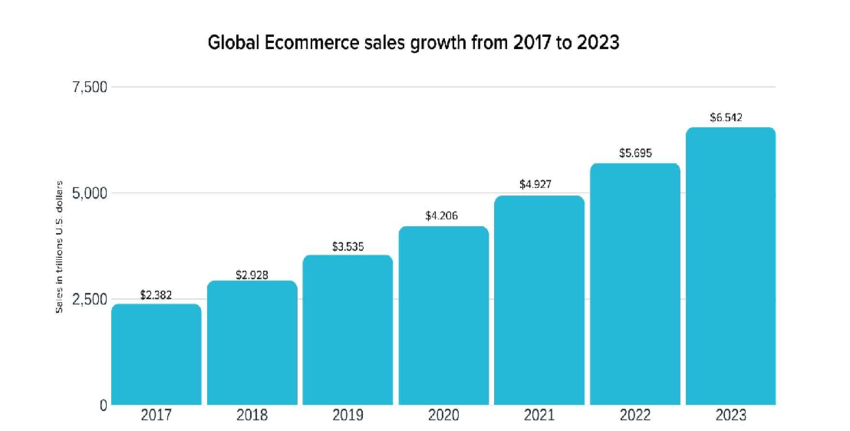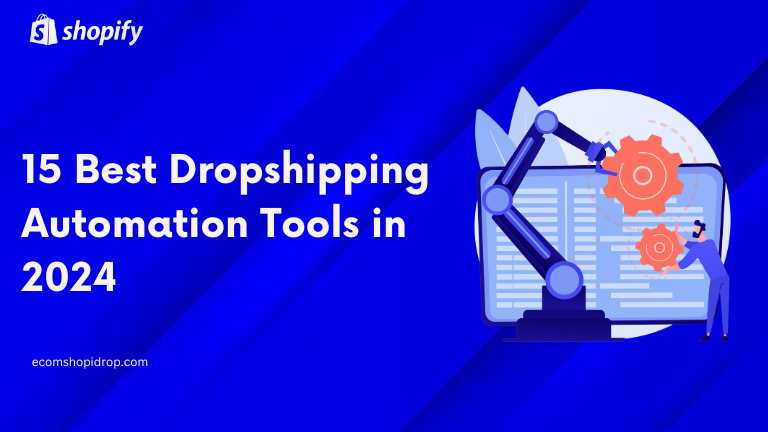
By the end of this guide, you will know why dropshipping is the future of ecommerce.
The world of ecommerce is constantly evolving, and dropshipping is at the forefront of this transformation. As a revolutionary retail fulfillment method, dropshipping has made it easier than ever for entrepreneurs to start and grow online businesses. But what exactly makes dropshipping so appealing, and why is it considered the future of ecommerce? In this comprehensive article, we will explore the various facets of dropshipping and its impact on the future of ecommerce landscape.
What is Dropshipping?
Dropshipping, a modern retail strategy, involves selling products without maintaining inventory. When a purchase is made, the seller buys the product from a third party, who then ships it directly to the customer. Consequently, the seller never handles the product directly. This model eliminates the need for a physical inventory, making it an attractive option for new and small businesses.
The concept of dropshipping is not entirely new. It has evolved over the years from traditional catalog sales to a modern, internet-based model. Key players in the dropshipping model include ecommerce platforms like Shopify and suppliers who manage inventory and shipping logistics.

The Rise of Ecommerce
Ecommerce has grown exponentially over the past decade, reshaping the way consumers shop. According to recent statistics, global ecommerce sales are projected to reach $6.4 trillion by 2024, up from $4.2 trillion in 2020. This surge is driven by changing consumer behaviors, such as the preference for online shopping due to convenience and the availability of a broader range of products.
Growth Statistics and Trends
The growth of ecommerce has been nothing short of phenomenal. In 2010, global ecommerce sales were just $4 billion. By 2020, this figure had grown more than sevenfold. The COVID-19 pandemic further accelerated this trend, as lockdowns and social distancing measures forced many consumers to shop online for the first time. As a result, even more people became accustomed to the convenience of online shopping.
Several key trends have emerged from this growth. Mobile commerce, or m-commerce, is one of the most significant. With the proliferation of smartphones, more consumers are shopping from their mobile devices. In fact, mobile commerce accounted for nearly 73% of total ecommerce sales in 2021, and this percentage is expected to increase.
Another trend is the rise of social commerce, where social media platforms like Instagram, Facebook, and TikTok have become powerful tools for ecommerce. These platforms enable businesses to reach vast audiences, create engaging content, and even facilitate direct purchases through integrated shopping features.

Changing Consumer Behaviors
Consumer behavior has shifted dramatically with the rise of ecommerce. Today’s consumers expect convenience, variety, and fast delivery. They are also more informed and empowered, often researching products and comparing prices before making a purchase.
Personalization has become a key factor in ecommerce. Consumers appreciate tailored recommendations and customized shopping experiences. Advances in AI and machine learning have made it possible for ecommerce platforms to analyze customer data and provide personalized product suggestions, improving customer satisfaction and boosting sales.
Moreover, the demand for ethical and sustainable products has grown. Consumers are increasingly concerned about the environmental and social impact of their purchases. They seek out businesses that prioritize sustainability, fair trade, and ethical sourcing. This shift in consumer preferences has prompted many ecommerce businesses to adopt more sustainable practices and offer eco-friendly products.
The Role of Technology in Ecommerce Expansion
Technology has played a significant role in the expansion of ecommerce. The widespread use of smartphones and high-speed internet has made online shopping more accessible. In addition, advancements in payment processing and security have built consumer trust in ecommerce platforms.
The development of user-friendly ecommerce platforms, such as Shopify, WooCommerce, and BigCommerce, has lowered the barrier to entry for online businesses. These platforms offer comprehensive solutions for setting up and managing online stores, including website design, inventory management, payment processing, and marketing tools.
Cloud computing has also revolutionized ecommerce. By leveraging cloud services, businesses can scale their operations efficiently and handle large volumes of data and traffic. Cloud-based ecommerce solutions provide flexibility, reliability, and security, ensuring that online stores can operate smoothly and meet customer demands.
Artificial intelligence and machine learning have further enhanced the ecommerce experience. AI-powered chatbots provide instant customer support, while machine learning algorithms analyze customer behavior to improve product recommendations and optimize marketing strategies.
Lastly, advancements in logistics and supply chain management have been crucial for the growth of ecommerce. Faster shipping options and more reliable tracking systems have enhanced the overall customer experience. Innovations such as drone deliveries and autonomous vehicles promise to make logistics even more efficient in the future.
Advantages of Dropshipping
- Low startup costs
- Minimal inventory risk
- Flexibility and scalability
- Wide product selection
- Location independence
Low Startup Costs
Dropshipping offers a range of benefits that make it an attractive business model for many entrepreneurs. One of the primary advantages is low startup costs. Without the need to purchase inventory upfront, new businesses can operate with minimal initial investment.
Minimal Inventory Risk
Another significant benefit is the reduction of inventory risk. Since products are only purchased after a sale is made, there is no risk of unsold inventory taking up storage space or tying up capital. This flexibility allows businesses to quickly adapt to market trends and customer preferences.
Flexibility and Scalability
Furthermore, dropshipping provides unparalleled scalability. As sales increase, businesses can expand their product offerings without the logistical challenges of managing more inventory. This model also supports a wide product selection, enabling sellers to offer a diverse range of products without significant financial commitments.
Wide Product Selection
The wide range of products available for dropshipping means that entrepreneurs can cater to various niches and market segments. This diversity allows for experimentation and the ability to pivot quickly based on market demands.
Location Independence
Lastly, dropshipping offers location independence. Entrepreneurs can run their businesses from anywhere in the world, as long as they have an internet connection. This freedom allows for a better work-life balance and the opportunity to travel while managing an online store.
Technological Innovations Driving Dropshipping
Automation and AI in Dropshipping
Advances in technology have significantly boosted the efficiency and appeal of dropshipping. Automation and artificial intelligence (AI) have streamlined many aspects of the business, from order processing to customer service. For instance, AI-powered chatbots can handle customer inquiries, while automated systems manage inventory updates and order tracking.
Integration with Ecommerce Platforms
Integration with ecommerce platforms like Shopify and WooCommerce has also simplified the process of setting up and running a dropshipping store. These platforms offer user-friendly interfaces and a wide range of apps and plugins that enhance functionality.
The Role of Big Data and Analytics
Big data and analytics play a crucial role in dropshipping by providing insights into consumer behavior and market trends. By analyzing data, businesses can make informed decisions about which products to offer and how to price them.
Improving Supply Chain and Logistics
Improvements in supply chain and logistics have also been instrumental in the growth of dropshipping. Faster shipping options and more reliable tracking systems have enhanced the overall customer experience, making dropshipping a more viable option for online retailers.
How Dropshipping Empowers Small Businesses
Dropshipping has leveled the playing field, allowing small businesses to compete with larger retailers. One of the most significant advantages is access to global markets. Through dropshipping, small businesses can reach customers worldwide without the complexities of international shipping and customs.
Low operational overheads mean that small businesses can allocate more resources to marketing and customer service. Instead of worrying about storage and shipping, entrepreneurs can focus on building their brand and engaging with customers.
Many small businesses have found success with dropshipping by carving out niche markets. For example, a store specializing in eco-friendly products or unique handmade items can attract a loyal customer base without needing extensive inventory.
Success stories abound in the dropshipping world. Entrepreneurs from various backgrounds have built thriving businesses by leveraging the flexibility and scalability of the dropshipping model. These stories serve as inspiration and proof that dropshipping can be a viable path to business success.
Challenges and Misconceptions About Dropshipping
Despite its many advantages, dropshipping is not without its challenges and misconceptions. One common challenge is managing supplier relationships. Ensuring that suppliers consistently provide high-quality products and timely shipping can be difficult, especially when dealing with international suppliers.
Another issue is maintaining customer satisfaction. Since dropshippers have limited control over the fulfillment process, they must rely on suppliers to meet delivery expectations. Delays or errors in shipping can lead to customer dissatisfaction.
Misconceptions about dropshipping often stem from the belief that it is a get-rich-quick scheme. While dropshipping can be profitable, it requires hard work, effective marketing, and continuous optimization. Another misconception is that dropshipping is easy to set up and manage. In reality, it involves complex processes such as market research, supplier vetting, and customer service management.
To overcome these challenges, dropshippers should establish clear communication channels with suppliers, set realistic customer expectations, and continuously monitor and improve their operations.
Dropshipping Trends to Watch
As dropshipping continues to evolve, several trends are shaping its future. One notable trend is the focus on niche markets and specialized products. By targeting specific customer segments, dropshippers can differentiate themselves from larger competitors and build loyal customer bases.
Sustainable and ethical dropshipping is also gaining traction. More than ever, shoppers prioritize the sustainability and societal implications of their buying decisions. Dropshippers who offer eco-friendly products and transparent supply chains can appeal to this growing market segment.
The rise of personalized products is another trend to watch. Advances in technology have made it possible for dropshippers to offer customized items, such as engraved jewelry or bespoke clothing, enhancing the customer experience and driving sales.
Social media continues to play a significant role in dropshipping. Platforms like Instagram, TikTok, and Facebook provide powerful tools for marketing and customer engagement. Influencer partnerships and social commerce features allow dropshippers to reach new audiences and boost their sales.
Dropshipping is The Future of Ecommerce
Looking ahead, dropshipping is poised to play an even more significant role in the future of ecommerce. Predictions and expert insights suggest that the dropshipping market will continue to grow, driven by increasing consumer demand and technological advancements.
Potential innovations, such as enhanced AI and machine learning applications, are expected to further streamline dropshipping operations. These technologies can improve inventory management, customer service, and marketing strategies, making dropshipping even more efficient and profitable.
Globalization and trade policies will also impact the future of dropshipping. As international trade barriers are reduced and logistics networks improve, dropshippers will have more opportunities to expand their reach and offer competitive shipping options.
Ultimately, consumer demand will shape the future of dropshipping. As customers seek convenience, variety, and personalized experiences, dropshippers who can meet these needs will thrive in the competitive ecommerce market.
Getting Started with Dropshipping
For those inspired to dive into dropshipping, there are several key steps to get started. The first step is choosing a niche and selecting products that cater to a specific market segment. Conducting thorough market research is crucial to identify profitable niches and understand customer preferences.
Next, setting up an ecommerce store is essential. Platforms like Shopify and WooCommerce offer user-friendly tools to create and customize online stores. Ensuring a professional and attractive website design can help attract and retain customers.
Finding reliable suppliers is another critical step. Entrepreneurs should vet suppliers thoroughly to ensure product quality and dependable shipping. Platforms like AliExpress, Oberlo, and SaleHoo can connect dropshippers with reputable suppliers.
Marketing and driving traffic to the store are vital for success. Utilizing social media, search engine optimization (SEO), and paid advertising can help attract potential customers. Building an email list and engaging with customers through newsletters and promotions can also boost sales.
Maintaining customer satisfaction is key to building a successful dropshipping business. Providing excellent customer service, addressing complaints promptly, and ensuring timely deliveries can enhance the customer experience and foster loyalty.
Embracing the Dropshipping Revolution
Dropshipping represents a significant shift in the ecommerce landscape, offering opportunities for businesses of all sizes. With its low startup costs, scalability, and flexibility, dropshipping is an attractive model for aspiring entrepreneurs. As technology continues to advance and consumer preferences evolve, dropshipping is set to become an even more integral part of the ecommerce world.
Ready to start your dropshipping journey? Check out our comprehensive resources and tools to get you started. Subscribe to our blog for the latest updates and insights, and join our community to share your experiences and learn from other dropshippers.
FAQ
Is dropshipping profitable?
Yes, dropshipping can be profitable if done correctly. Success depends on factors such as niche selection, supplier reliability, effective marketing, and customer service.
How much does it cost to start a dropshipping business?
Starting a dropshipping business requires minimal upfront investment. Costs typically include setting up an ecommerce store, marketing, and purchasing initial products for testing.
Can I run a dropshipping business from anywhere?
Yes, one of the main advantages of dropshipping is location independence. As long as you have an internet connection, you can manage your business from anywhere in the world.
Finding reliable suppliers involves thorough research and vetting. Using platforms



